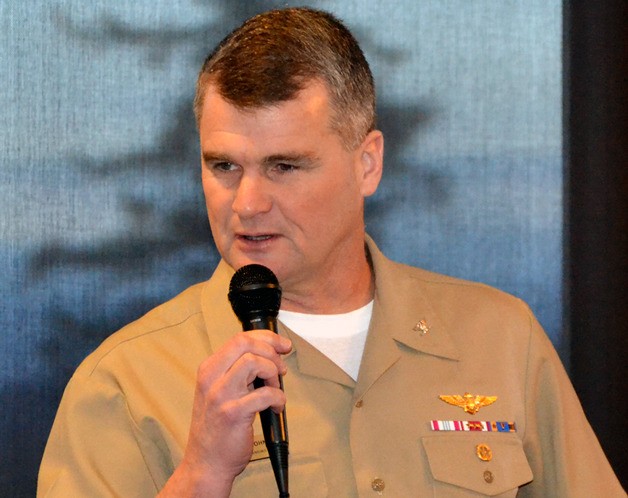Members of the South Whidbey Rotary hosted a very important person from the north at the group’s meeting Tuesday morning at the Useless Bay Golf and Country Club in Langley. Several members of the Whidbey Westside Rotary were also in attendance.
Capt. Jay “Tank” Johnston, commanding officer of Naval Air Station Whidbey Island, was the guest speaker. He shared a brief overview of NAS Whidbey, explaining the tenant commands housed on base and the role those commands play in NASWI’s overall mission.
The strategic location of Whidbey Island couldn’t be better for protecting U.S. interests in the Pacific, Johnston said. Lighter flight patterns mean more open air space and our geographic location is closer to heavily traveled shipping lanes
Of particular interest however, was the noise issue arising from Field Carrier Land Practice at Outlying Field just south of Coupeville.
“The noise issue hit a new level of complaints this year,” Johnston said, explaining there were actually fewer flights in 2012 than the previous year, but that there were more complaints than ever.
Johnston noted carrier landings are difficult and require practice on land before a squadron can be deployed to a ship.
“It’s a very difficult thing to do. You’ve got to get the two back wheels and the hook down at the same time. It takes practice,” he said. “Coupeville is a prime training area, because it’s dark, isolated and allows pilots to focus on what they’re doing.”
Each pilot practices six “touch and go” landings during each flight, Johnston said. Each squadron has three or four planes, meaning a total of at least 18 or 24 of the maneuvers at a time, which, he acknowledged, means it can get noisy.
There are currently 14 squadrons on NAS Whidbey. Three of those squadrons are expeditionary, meaning they are land-based and do not conduct flight operations at Outlying Field. Complaints, he said, are taken seriously.
“We track every noise complaint we get,” said Johnston. “We will call every caller (who leaves a number) back. But there really is nothing we can do to change the training.”
Johnston praised recent efforts of community and Navy leaders to begin publishing some limited practice schedules to give people a general idea of when flights will take place. But in the end, Johnston said, it all comes down to safety and security.
“Believe me, there are a lot of things those crews would rather be doing at 2200 hours on a Thursday,” Johnston said. “But we’re out there working hard to get the job done.”
Johnston, who took command of NAS Whidbey Island in August, 2010, will be moving on to another post soon. His change of command ceremony is scheduled for Feb. 22.



